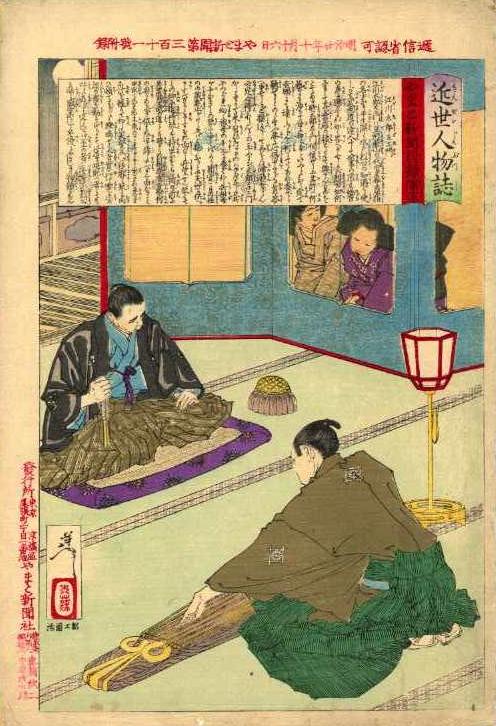
|
|
Yosha Bunko
|
Kinsei Jinbutsu Shi
Yamato Shinbun Furoku No. 13
Egawa Tarozaemon
Yoshitoshi catches Egawa Hidetatsu (江川英龍 1801-1855), aka Tannan (坦庵), and here called Tarōzaemon (太郎左衛門), playing a koto, while the lord of Mito domain intently listens. Egawa was also a master of the art of gunnery and responsible for Edo's coastal defences.
Egawa designed the gun batteries that were built in the offing of Shinagawa in Edo Bay after the arrival of Commodore Perry's black ships in nearby Uraga, at the mouth of the bay, in 1853. He had been involved in the region's coastal defences since the 1830s.
Only a few of the planned batteries were built on small artificial islands near the shore. Called "Shinagawa daiba" (品川台場) or "Odaiba" (御台場), they were never fired against an enemy vessel and were soon abandoned.
By the late 1920s, the site of one of the batteries had been turned into a tourist attraction. Today this battery, and vesitges of a couple of the other islands, are part of the popular Odaiba development built mostly on landfill along the waterfront of Tokyo Bay.
The man with his back to the brush
Cathrine E. Lowther, on her Sinister Designs website, makes the following comment about this print (retrieved 24 January 2010).
|
Although I am told the title of this print refers to Egawa playing the koto, given the nature of the print, and the series, it seems to me more likely that he is the man listening to the koto player.
|
There may be prints on which the graphic story contradicts the written story. But the graphic and written stories on this print are one and the same.
The title -- like the titles of all the prints in this series -- states only the name of the protagonist -- Egawa Tarōzaemon (江川太郎左エ門 えがハたらうざゑもん Egaha Tarauzawemon). And the protagonist here -- like those in the other prints -- is the person engaged in the principal action portrayed in the graphic and written stories.
The written story relates that Egawa learned to play the koto when a child from his grandmother. His host, having heard this, produced a koto and placed it before Egawa, who quietly rose to the challenge.
The last line disclosure's the identity of man on the cushion (my structural translation).
|
・・・一坐(いちざ)の者(もの)ハ云迄(いふまで)もなし烈公(れつこう)も深(ふか)く感心(かんしん)ありしと・・・
. . . as for those present, needless to say Rekkō also deeply has admiration . . .
|
Rekkō (烈公) was the posthumous name of Tokugawa Nariaki (徳川斉昭 1800-1860), the lord of Mito domain and the father of Yoshinobu, who would become the last Shogun. And indeed the drawing suggests that the man on the cushion is of very high status.
Like the written story, though, the graphic story, too, is about the accomplishments of the man of meaner standing, who is kneeling with his back to Yoshitoshi's brush. (WW)
| 